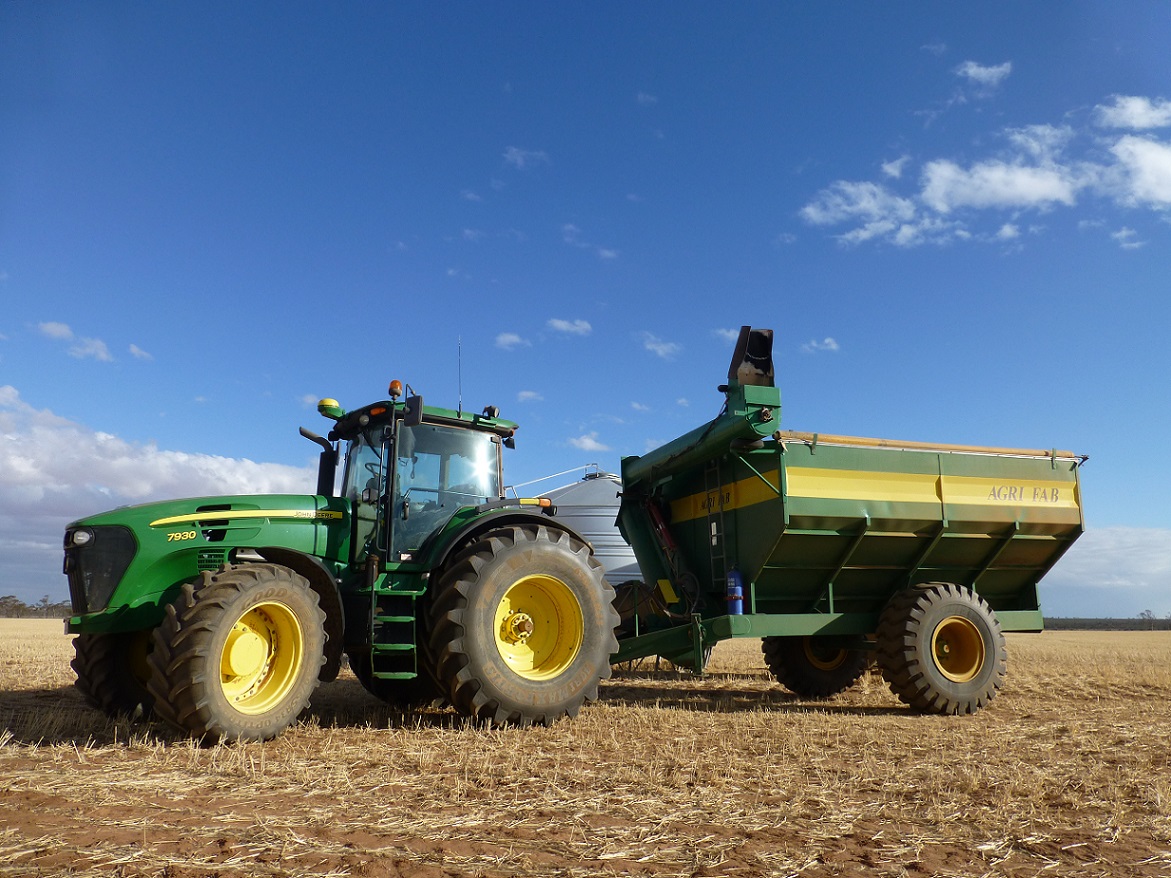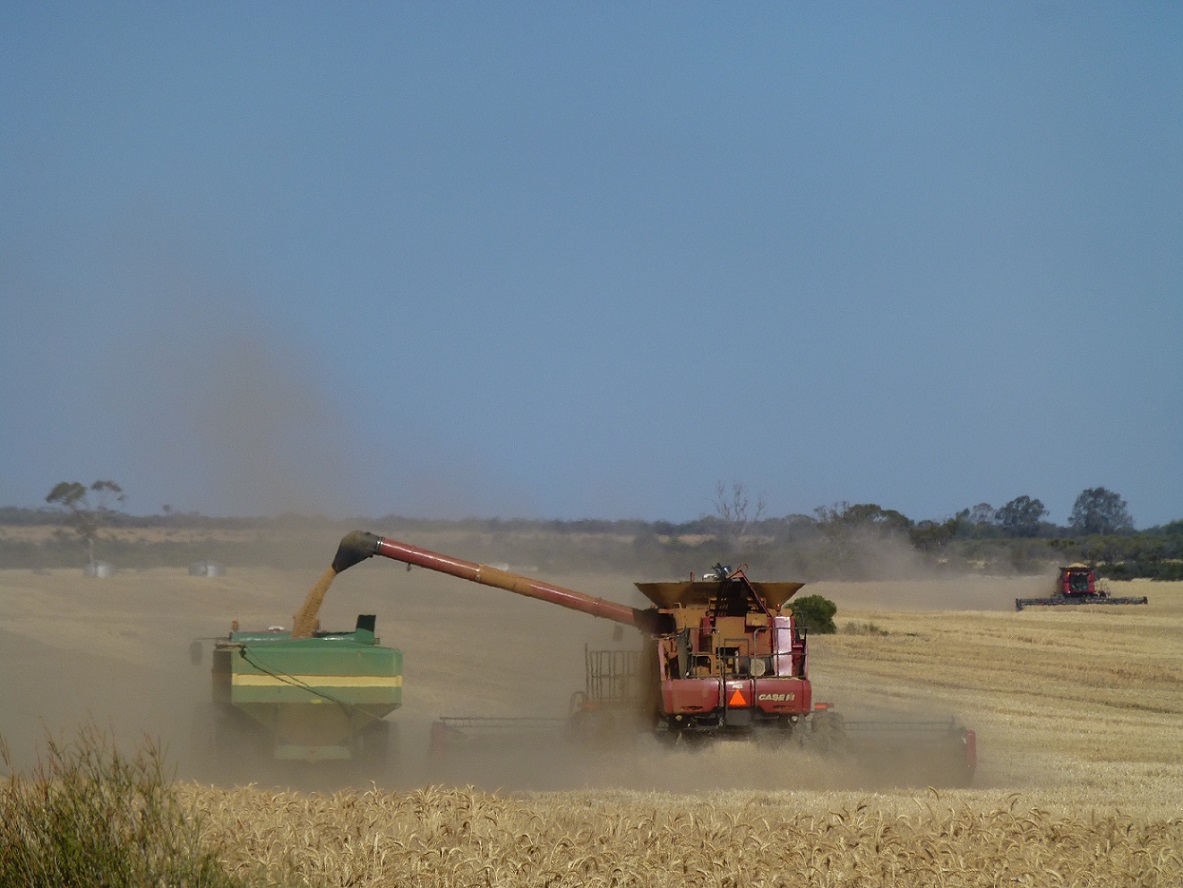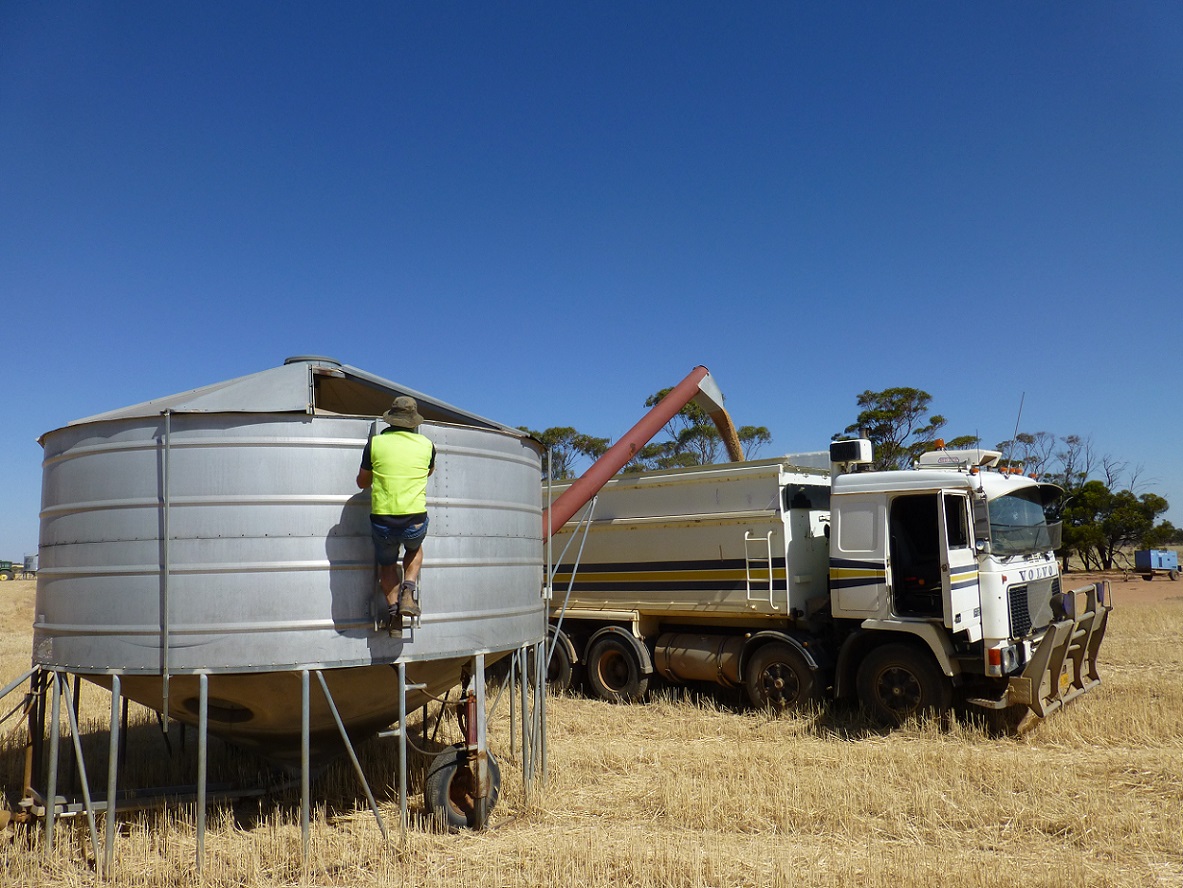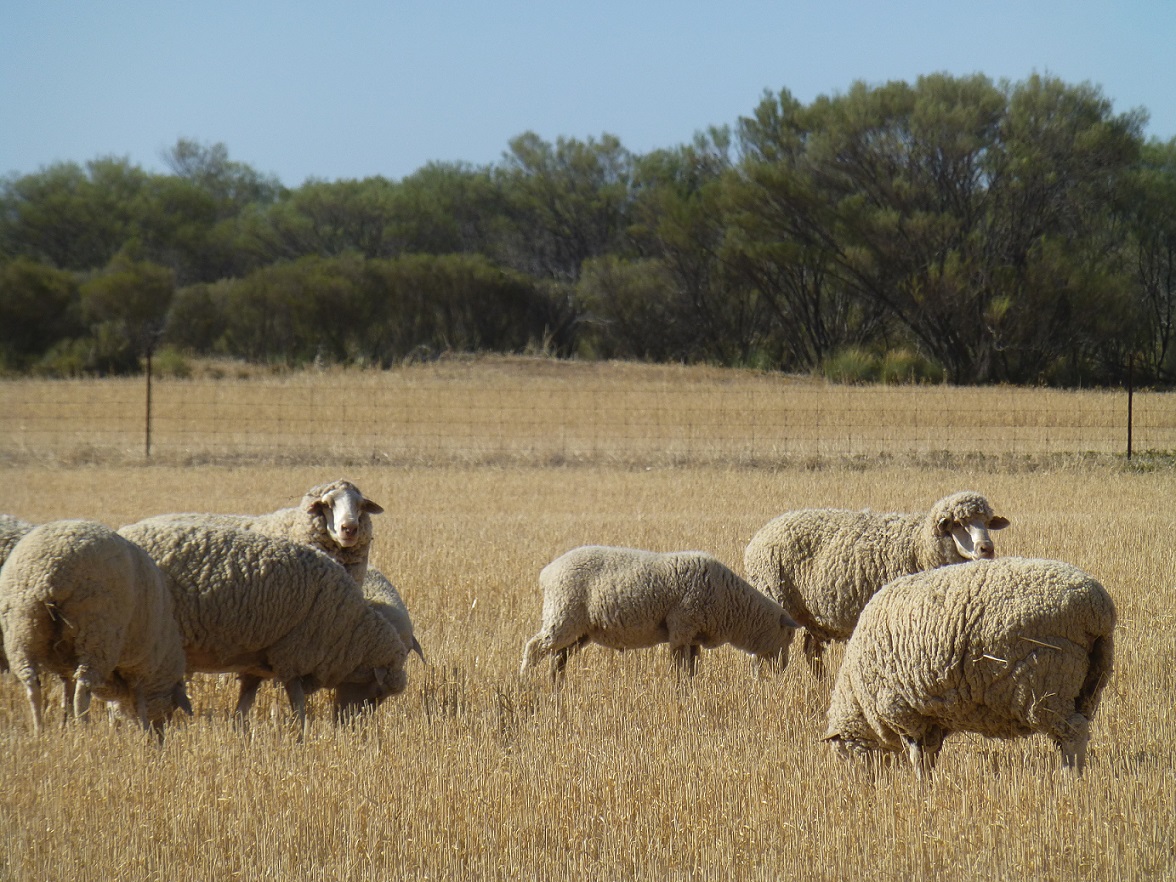Like an alien fresh off the spaceship, I landed bright-eyed and bushy-tailed in the Wheatbelt Way 12 years ago. I had very little knowledge of farming. However I was keen, my work boots were on, and I was coming up to do harvest! I enjoyed that harvest, and have learned more about it as a layperson since.
Turns out that harvest is a bit like a very busy hive of bees. Everyone has their role to play and all the worker bees come out of the woodwork to get the job done. The roads and the paddocks are busy, and there is an additional injection of activity and life into communities. There is also a happy sense of participation, as well as a sense of getting near to completion because the crop is coming off and the end of the year is nearing.

A farmer harvesting his crop with a header. Notice the spacious cab offering a clear view of the crop ahead.
Long hours of summer sun help farmers get the crop off, so that they can finally get paid for the many hours of hard work they have put in over the whole year. Farmers need to get the crop off as quickly as possible, because summer storms and hail can damage the crop irreversibly, flushing all those long hours of toil down the gurgler instantaneously. As a result, farmers always focus on getting their best crop off first.

Waiting for Dad to finally get off the header. Photo courtesy of Kylie Rowe.

A header with its large front comb raised.
Crops are harvested using “headers.” The name header comes from the ability of the machine to remove the heads from the straw. Headers are absolutely wonderful machines because they have the ability to convert crops covering wide paddocks into a mound of clean golden grains ready for delivery. The formal name for a header is actually a “self-propelled combine harvester,” so you can understand why the term header is used instead.

Ready for harvest – heads of wheat positively bursting with plump little grains.
A header basically works in the following way: the large comb at the front of the header cuts the “heads” off the crop and these are fed up into the machine on a conveyer belt, where they are threshed to release the grains from their cosy husk. Headers can actually process a number of cereals, including wheat, barley, lupins and oats. The grains are then drawn up into a “bin” or “box” behind the cab that stores a certain amount of grain within the machine itself. Once the threshing process is completed, the chaff and unwanted pieces of straw are regurgitated out the back of the machine. A moveable arm called an unloading auger is also attached to the header to allow the bin full of grain in the header to be emptied into a truck, field bin or chaser bin.
If you’d like to, you can check out the below short video of a header in action:
https://youtu.be/2IsKo0Wh4T0
And the below short video of the comb cutting the heads off the straw:
https://youtu.be/pkZ4XN5XRok

The bin or box on a header. You can see the cab of the header immediately to the front of it.

Grains of wheat tumbling down into the header’s bin as it harvests.

The header bin getting close to full visible through the window at the back of the cab, with the reflection of farmer and header comb in the window.

Happy fat little grains of wheat in the hard working hands of a farmer. Photo courtesy of Kylie Rowe.

Unwanted chaff and straw shoots out the back of the header as it harvests.
Headers are extremely expensive machines, costing between $750,000 and $1,000,000 to buy new. As a result, many Wheatbelt Way farmers maintain their machines very well in order to get many years of service from them. The header in the photo above is actually 23 years old and the farmer that owns it is very careful to grease the header up every day. “Greasing up” involves applying grease to grease nipples on shafts of the header. As the header is made up of many moving parts that work hard all day, keeping the machine adequately greased ensures that the machine is adequately lubricated, reducing the need to replace bearings and other parts.

A farmer checking his header over at the end of the day. The comb has been safely raised before parking the header overnight.
The header comb in the above photograph is around 9 metres or 30 foot long. Most modern header combs are between this size and 18 metres or 60 foot long. As a result of the length of header combs, when headers are moved around the comb has to be removed and placed on a “comb trailer.” The header is driven to the next location without its “nose,” which is re-attached once it reaches its destination. Due to the length of the comb, at the end of the working day headers are also usually parked with their combs off the ground. This ensures that if there is a flat tyre on the header overnight, the long comb sitting across its front isn’t damaged by impact with the ground. Header parts are also extremely expensive, and any damage is very costly in terms of parts as well as lost operating time.
Many farmers deposit their harvested grain in field bins, which hold the grain temporarily until the truck driver turns up to take a load to the local delivery point (delivery points are usually known as “wheat bins”, but they actually receive various grains, feature both shed and outside storage, and usually include a transportable house that accommodates staff over harvest).

The unloading auger on the header emptying a bin full of wheat into a field bin in the paddock.
A field bin is basically a bin on wheels. They are marvelously useful when farmers are harvesting in paddocks across large areas of land and need to be able to move storage to wherever they are working. Incidentally, they are also handy for storing a quantity of seed wheat held aside for sowing next year’s crop.

On the move – the base of the field bin is simply raised and the farmer then tows the field bin to a new paddock on its own wheels.
Some farmers also use “chaser bins” to help get their crop off. Chaser bins enable a header driver to offload their full bin off grain without stopping at all. A chaser bin being towed by a tractor simply pulls up alongside the header and the grain in the bin is offloaded while the header is still harvesting. The chaser bin then pulls away and offloads the grain, either directly into a truck or into a field bin for later collection. Chaser bins cost around $100,000, and they also need a tractor of reasonable size to tow them around. The larger “mother” bins that some farmers use to store up to 100 tonnes of grain cost around $250,000.

A tractor towing a chaser bin.

A header unloading into a chaser bin as it continues to harvest. This requires precision, vigilance and concentration on the part of both operators.

A large “mother” bin in a paddock, with ute and fire fighting unit nearby in case of a fire.
Regardless of whether field bins or chaser bins are used, or grain is taken straight from the header, a truck driver will eventually turn up to collect the grain and take it to the wheat bin or to other on-farm long term storage. In the case below, the truck driver is filling the truck with wheat from a field bin.

A truck driver checking the amount of grain left in the field bin while filling up the truck.

A mound of golden wheat forming in the back of the truck.

A truck being sampled at a Wheatbelt Way wheat bin. The large hydraulic arm sucks samples of grain out of the truck, which is then analysed in the sampling shed.
After sampling and weighing in, the truck is then sent around to tip off its load. Grain is always tipped off into a grid, and from there it goes into either shed storage or open storage facilities. Open storage facilities are covered with large tarpaulins to protect the grain from the elements.

Warm golden grains of wheat spill out of the truck and into the grid at the local wheat bin.

An open storage facility at a wheat bin. Additional tarpaulin is progressively added to cover the stack as it grows over harvest.
When farmers deliver their grain to the wheat bin, they are penalised for “screenings,” or small shrivelled grains that have not filled out properly. Screenings are more of a problem if unfavourable conditions such as a lack of finishing rains occur during the growing season. If screenings are present when farmers harvest certain paddocks, they will sometimes put their grain through seed cleaners like the ones in the below photographs to remove small grain and receive a better price at the delivery point.

A seed cleaner which happens to look remarkably like an over-sized Dalek from Doctor Who.

A seed cleaner in operation – you can see the grains of wheat visible in the bottom window of the grader.
But really, the header will always be the star of the harvest show. These days the cab of headers is much wider than it used to be, and most cabs include a “trainer seat” or small seat next to the main operator’s seat to assist with training or allow the kids to spend a bit of time with Dad or Mum on the header. Headers are also now equipped with a variety of lights to assist farmers who wish to harvest at night when weather conditions are suitable. In the past, headers were only equipped with basic headlights for moving the machine down the road, and farmers were restricted to working during daylight hours.

The cabs of more modern headers look a bit like the cockpit of a plane, with displays, levers and buttons all over the place. Photo courtesy of Kylie Rowe.
Headers also now have an enclosed air conditioned cab that allows farmers to work in comfort even on the hottest days of harvest. Originally, many headers were completely open air, and offered absolutely no protection to the operator from dust, chaff or heat whatsoever. A farmer I know started on the next stage of header that appeared on the market. These were open air but came with their own beach or café style umbrella that the operator would simply pop out above their head for some protection from the sun (the umbrella even had the machinery company’s logo on it!). Apart from that, farmers at the time simply had to wear sunglasses and hope for a headwind. If they were unlucky enough to cop a tailwind, chaff from the back of the header would drift back, covering their body and clogging up their airway for the duration of their shift.

A modern header harvesting an excellent crop of wheat. Photo courtesy of Kylie Rowe.
After umbrella style headers, enclosed cabs with “water coolers,” or evaporative air conditioning systems came in. These worked in the same way as evaporative air conditioners that are still used in houses do, with water being used to cool the air in the cab. Water was held in a bowl above the cab, and this had to be refilled regularly. A jerry can of water only barely lasted until lunchtime. Also, if the header operator went too fast over a bump, they would receive a cold shower from the water bowl above! Thankfully, refrigerated air conditioning systems eventually came in, and headers now even incorporate GPS and yield monitoring systems. However, the overall process of harvest and the challenges that all farmers face have not changed.
The risk of fire over harvest is one of those challenges. A combination of warm summer weather, oxygen, a fuel source in the form of chaff or grain (as well as the diesel that powers the header’s engine), and heat from a machine that has lots of warm moving parts, means that harvest can present a very real fire risk. Extremely hot weather and strong winds usually result in the local fire brigade banning all harvest activity, frequently for the remainder of the day.

Shimmer from a summer heat haze is visible in the above photograph.
As a result of the risk of fire, farmers are also legally required to have a fire fighting unit on standby wherever they are harvesting. Header drivers are also very careful to check their machines, and monitor any unusual sounds or smells very closely. At night, headers are also usually parked so that there is a gap between the header and other headers or machinery. This way if a fire starts within the header, it doesn’t spread to other machinery or headers in the vicinity. Three headers went up in smoke together in the wheatbelt when this didn’t happen a few years ago.

A trusty fire fighting unit on standby at the edge of a paddock.
At the opposite end of the spectrum, cold weather also causes headaches for farmers during harvest. Cold weather raises the moisture content within the grain, and it will be rejected at the wheat bin if it gets too high. Also, cold weather makes the straw of all cereal crops softer (or harder for the header to thresh), so if you start harvesting on a morning when the temperature hasn’t warmed up enough, you end up with “whiteheads.” Whiteheads do not actually refer to a break out of pimples (though you may have one of those as well!), they are in fact just unthreshed heads of wheat still in their husk which attract penalties at the wheat bin.

A field bin with its lid open.
Rain during harvest is even worse. When there is rain on the horizon, there is a flurry of activity as staff rush out and close the lids at the top of field bins, which are left open most of the time to facilitate filling them with grain. Many headers are not made with a cover for the “bin” or “box” that holds the grain collected by the machine, so some farmers make up a tarpaulin style cover to protect them in the event of rain. Other farmers simply ensure any grain in the bin is emptied into a truck or field bin before rain, and then after rain, they drop the doors at the bottom of the bin and wash any rotten or mouldy grain out. Wet mouldy wheat has an extremely strong and unforgettably unpleasant stench, so farmers do anything to avoid significant quantities of rotten grain.
Hail is also a huge problem for farmers. Farmers can and do produce beautiful crops that are wiped out by hail in a flash before they get a chance to harvest them. Hail basically strips the “heads” that contain the grain off the crop, and if it is severe enough it will flatten the crop completely too. As a result, many farmers insure their crops against hail damage.

Once the crop is finally off for the year, the sheep are let loose on the paddock to hoover up any remaining goodness. This is called putting the sheep out on the “stubble.” The straw of some cereals left in the paddock after harvest, like lupin, barley and oats contains food value, and sheep benefit from eating this, as well as any unharvested heads of grain that remain in the paddock. Headers have however become increasingly efficient, and as a result, there aren’t as many unharvested heads leftover for the sheep to eat. However, sheep do still benefit from being placed out on stubble for a period of time, and farmers simply move them from paddock to paddock once they clean up each.

Some rather round sheep happily eating the stubble left over after a paddock has been harvested.
As for the rest of us, we celebrate the end of harvest with a beer.

Cheers and see you somewhere on the Wheatbelt Way!
By Annemaree Jensen who writes at www.extramilewriting.com.au. Huge thanks go to Tom Daddow and Kylie Rowe for their generous and awesome assistance with this article.



